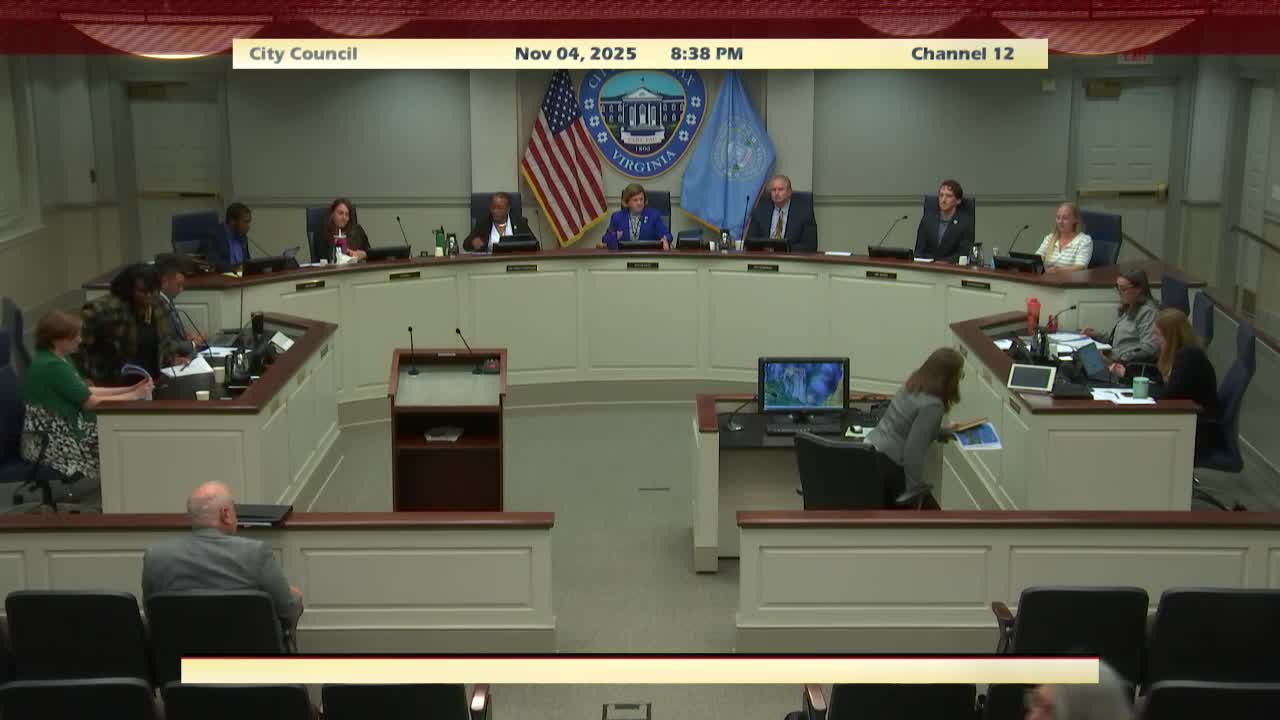Zero‑fare Q pilot shows large ridership gains; consultants present cost scenarios and equipment costs
November 04, 2025 | Fairfax City, Fairfax County, Virginia
This article was created by AI summarizing key points discussed. AI makes mistakes, so for full details and context, please refer to the video of the full meeting. Please report any errors so we can fix them. Report an error »

City transportation staff and outside consultants presented an evaluation of the Q (CUE) zero‑fare pilot at the Nov. 4 work session, summarizing ridership trends, community benefits and the financial and operational impacts of possible fare reinstatement.
Transportation Director Wendy Sanford introduced consultants from Kinley Horn, who described the history of the pilot: fares were suspended during the COVID‑19 emergency and the city received a DRPT step‑down grant that offset lost fare revenue. The grant has phased down and is expiring, prompting the evaluation ahead of the FY27 budget cycle.
Consultants reported that ridership reversed a prior decade‑long decline and is expected to exceed 1,000,000 trips in the current reporting year, an approximately 60% increase from pre‑pandemic levels despite no increase in service hours. An onboard and online survey showed riders overwhelmingly support the zero‑fare policy; the consultants said two‑thirds of riders indicated they would ride less frequently if fares were reinstated.
The evaluation considered two broad policy paths: maintain zero fare (and identify ongoing funding to replace the expiring grant) or reinstate fares. For reinstatement the team modeled four fare scenarios (base fares ranging from $1.00 to $2.25 and various discounted populations). Consultants estimated ridership declines of roughly 11%–34% depending on fare level and discounting; that translates to 100,000–350,000 fewer annual trips in model scenarios.
A substantial component of the financial analysis covered capital and recurring costs of fare collection. The consultant team estimated a modern farebox costs roughly $50,000 per vehicle once equipment, installation and spare parts are included; equipping the city's fleet (12 vehicles, 8 in service with spares) was estimated near $600,000 in year‑one capital outlay. Recurring costs for cash handling, armored transport and maintenance were estimated on the order of $150,000 per year; consultants reported these operational costs could reduce gross fare revenue by 29–41% in their modeling.
Consultants and staff also flagged operational complexities: cash handling, farebox maintenance and the need for staff training; fewer rider/operator confrontations and reduced dwell time were cited as benefits of remaining fare free. The analysis noted that in a regional fare matrix the fare share returned to the city depends on trip start and end points and that not all collected fare dollars stay with Q.
Staff and consultants recommended council consider all elements — ridership, equity, operational complexity and one‑time and recurring costs — in the FY27 budget. They said there is no immediate vote required; the report will be integrated into upcoming budget discussions.
Sources: presentation and Q&A at the Nov. 4 Fairfax City work session; consultant slides and onboard/online survey results.
Transportation Director Wendy Sanford introduced consultants from Kinley Horn, who described the history of the pilot: fares were suspended during the COVID‑19 emergency and the city received a DRPT step‑down grant that offset lost fare revenue. The grant has phased down and is expiring, prompting the evaluation ahead of the FY27 budget cycle.
Consultants reported that ridership reversed a prior decade‑long decline and is expected to exceed 1,000,000 trips in the current reporting year, an approximately 60% increase from pre‑pandemic levels despite no increase in service hours. An onboard and online survey showed riders overwhelmingly support the zero‑fare policy; the consultants said two‑thirds of riders indicated they would ride less frequently if fares were reinstated.
The evaluation considered two broad policy paths: maintain zero fare (and identify ongoing funding to replace the expiring grant) or reinstate fares. For reinstatement the team modeled four fare scenarios (base fares ranging from $1.00 to $2.25 and various discounted populations). Consultants estimated ridership declines of roughly 11%–34% depending on fare level and discounting; that translates to 100,000–350,000 fewer annual trips in model scenarios.
A substantial component of the financial analysis covered capital and recurring costs of fare collection. The consultant team estimated a modern farebox costs roughly $50,000 per vehicle once equipment, installation and spare parts are included; equipping the city's fleet (12 vehicles, 8 in service with spares) was estimated near $600,000 in year‑one capital outlay. Recurring costs for cash handling, armored transport and maintenance were estimated on the order of $150,000 per year; consultants reported these operational costs could reduce gross fare revenue by 29–41% in their modeling.
Consultants and staff also flagged operational complexities: cash handling, farebox maintenance and the need for staff training; fewer rider/operator confrontations and reduced dwell time were cited as benefits of remaining fare free. The analysis noted that in a regional fare matrix the fare share returned to the city depends on trip start and end points and that not all collected fare dollars stay with Q.
Staff and consultants recommended council consider all elements — ridership, equity, operational complexity and one‑time and recurring costs — in the FY27 budget. They said there is no immediate vote required; the report will be integrated into upcoming budget discussions.
Sources: presentation and Q&A at the Nov. 4 Fairfax City work session; consultant slides and onboard/online survey results.
View full meeting
This article is based on a recent meeting—watch the full video and explore the complete transcript for deeper insights into the discussion.
View full meeting
